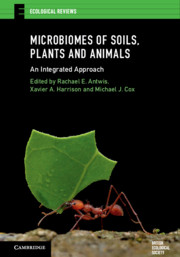Book contents
- Microbiomes of Soils, Plants and Animals
- Ecological Reviews
- Microbiomes of Soils, Plants and Animals
- Copyright page
- Contents
- Contributors
- Preface
- Abbreviations
- Chapter One Microbiomes of soils, plants and animals: an introduction
- Chapter Two Analytical approaches for microbiome research
- Chapter Three Microbiomes of soils
- Chapter Four Factors that shape the host microbiome
- Chapter Five Microbial symbioses and host nutrition
- Chapter Six The microbiome and host behaviour
- Chapter Seven Host microbiomes and disease
- Chapter Eight Adapting to environmental change
- Chapter Nine Microbial biotechnology
- Chapter Ten Synthesis and future directions
- Index
- Plate Section (PDF Only)
- References
Chapter Six - The microbiome and host behaviour
Published online by Cambridge University Press: 07 March 2020
- Microbiomes of Soils, Plants and Animals
- Ecological Reviews
- Microbiomes of Soils, Plants and Animals
- Copyright page
- Contents
- Contributors
- Preface
- Abbreviations
- Chapter One Microbiomes of soils, plants and animals: an introduction
- Chapter Two Analytical approaches for microbiome research
- Chapter Three Microbiomes of soils
- Chapter Four Factors that shape the host microbiome
- Chapter Five Microbial symbioses and host nutrition
- Chapter Six The microbiome and host behaviour
- Chapter Seven Host microbiomes and disease
- Chapter Eight Adapting to environmental change
- Chapter Nine Microbial biotechnology
- Chapter Ten Synthesis and future directions
- Index
- Plate Section (PDF Only)
- References
Summary
The potential for microorganisms to affect host behaviour has been recognised for decades, particularly with respect to parasites, but research into the wider influence of microorganisms on host behaviour and communication is now also gaining more interest. Microbial communities and associated metabolites can affect satiation, cravings and dysphoria that can influence feeding behaviour and nutrient acquisition. Microbial communities can also synthesise hormones that are analogous in structure and function to those produced by the host, as well as degrade or metabolise host-derived hormones. This can affect host mood and stress, as well as reproductive behaviours and fecundity. The gut microbiome also plays a key role in normal cognitive development of mammals, including aspects such as learning and memory. Furthermore, microbial metabolites are critical for scent communication, such as pheromone production, across many different species, and may also play a role in pollinator attraction by plants. However, the literature is largely biased towards mammals, and in many cases the mechanisms underlying microorganism-induced host behavioural changes still need identifying.
Keywords
- Type
- Chapter
- Information
- Microbiomes of Soils, Plants and AnimalsAn Integrated Approach, pp. 98 - 121Publisher: Cambridge University PressPrint publication year: 2020
References
- 1
- Cited by



